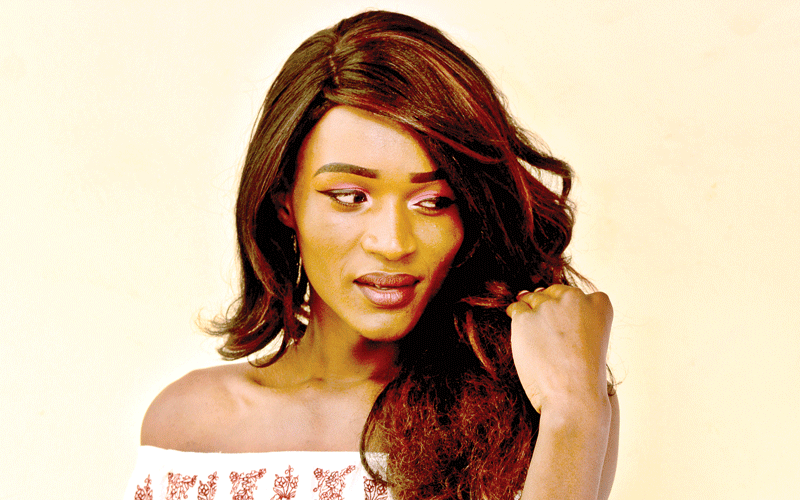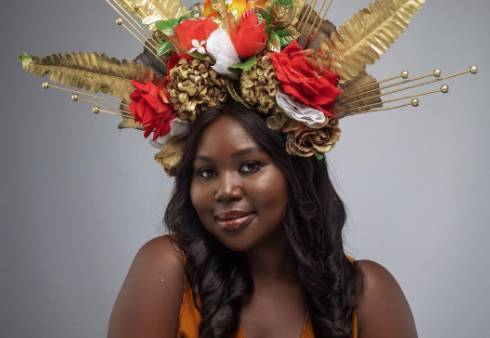Cross-dress: Fashion craze or disorder?

The idea of a man taking pleasure in putting on a tight dress or even stockings seems laughable, pitiful and plainly sinister, but today, men are concealing masculine traits so well, turning an ordinary Brian into an extraordinary Brianna
Sandra Wekesa @wekesa_sandra
The subject of cross-dressing took centre stage in Kenya in 2018 when Peter Ngong’o, the son of Kisumu Governor Anyang’ Nyong’o, showed up at the 10th anniversary of Blankets and Wines clad in a dress.
Other publicly known crossdressers in the country include fashion choreographer Jaffer Jackson, fashion model Letoya Johnstone, singer Joji Baro and digital content creator and lifestyle vlogger Jayson Mbogo aka jaytakeapic. Perhaps, many more have not come out in public yet.
A growing number of men are embracing cross-dressing either as a form of self-expression, art, culture, a way of entertaining or for sexual reasons.
Brantone Fidel Casro aka Brandy Sugar, a Kenyan pround cross-dresser, wonders why it is generally acceptable for women to dress in masculine clothes, but at best, cross-dressing men are still viewed as attention-seeking, eccentric or mildly amusing, while all they are doing is being themselves.
“Why are certain clothes tied down to a specific gender? Why would it be okay for a woman to put on a trouser and not the opposite for a man? I think time is ripe for us to rethink this. It needs to be balanced,” he poses.
Masculine clothes
Although he raises eyebrows whenever he goes out dressed in feminine clothes, Brandy says all that matters to him is the fact that he is comfortable. “I feel more comfortable, natural, joyful and beautiful when I am dressed as a woman,” says Brandy.
He, however, clarifies that he doesn’t always cross-dress, there are days he dresses in normal masculine clothes and still feel okay.
She recalls how it all began. “I had just joined secondary school in 2010 when my love for women’s clothes and make-up struck.
I would occasionally dress up like a woman and behave like one, and it caused a stir among my schoolmates.
My mother panicked over the sudden change in my dressing and tried to talk me out of it, though it was in vain,” he says, adding, “I have not always felt or attached to being male, but always felt female,” he narrates. In school, Brandy, as he likes to be called, felt boxed.
“I felt like I was in the wrong place, like the only woman in the midst of many men. And the boys mocked and made fun of me,” he recalls.
Little did he know that the boy’s scoffing would progress into something so tragic. One day, he was cornered by a group of older boys who raped him in turns.
“I hate thinking about that incident,” he says covering his face. “Through out the rape ordeal, they kept saying that since I was acting like a woman, they were going to use me, what men do to women,” he painfully recounts the horrific attack.
He told his mother about the dreadful incident and his mother transferred him to another school, a day school.
He opted to dress up as a man, behave like men, hang out with men and even hit on women, but Brandy says he just did not feel right. He just ended up getting attracted to men.
He avoided dressing up as a woman to ward off the teasers, but still his girly walking style would sell him off.
Soon after high school, he would resort to dressing up as a woman, but hide indoors. The first time he went out as a cross-dresser was to a party organised for cross-dressers.
In the days that ran up to that event, he was on the moon. “ I was excited. I felt like I was going to be myself in public for the very first time.
That evening I pulled out a dress that I had always wanted wear for such as occasion from my closet and tried it on with a pair of heels,” he beams.
Even though, to his surprise, he turned out to be the only one in a dress that night, it was one of the best nights. Life as a cross dresser, he says comes with its own share of challenges.
“I have been forced to move around in taxis and if I have to use public transport, it has to be at night,” he says.
Other times, he gets confronted by irate mobs, “I remember one time while walking in Nairobi’s downtown with my two female friends, I was almost attacked by a hostile group of men who kept shouting at me telling me to go get dressed like a ‘normal man’.
I was so scared for my life. If I stayed there a little longer, I would have been lynched. I promised myself never to walk along that road again,” he narrates.
Schools of thought
Eric Murunga another Kenyan cross-dresser says he started experimenting with make-up when he was in primary school.
“I was eight years old when I first tried putting on my aunty’s baby powder and eyeliner to make my eyes pop,” he chuckles.
But he started seriously cross-dressing when he turned 22 in 2012. “During the day, I would stay indoors dressed as a woman and get out at night usually to nightclubs and I would have so much fun,” he says.
As a cross-dresser, Erika as he calls himself tries to find clothes that work for his body that will still make him look as feminine as possible.
Sometimes he does a mix of male and female attires depending on the look that he wants to rock on that particular night or event.
Cross-dressing is a practice where a person wears clothes that are traditionally thought to be worn only by a person of the opposite sex.
Steven Asatsa, a consultant psychologist says various psychological schools of thought conceptualise this phenomenon differently. Veteran Psychologist Carl Jung believes that all human beings are psychologically bisexual.
This implies that every man has a feminine side and every woman has a masculine side. “For a long time, society has been discouraging people from expressing or accessing their opposite side.
The denial of similarities between men and women still shapes thinking in the modern society,” he explains.
Also other schools of thought look at it as gender dysphoria where those concerned feel as if they are ‘trapped’ in the wrong body. “It makes a person dissatisfied with their biological sex and strives to align with behaviour associated with the opposite sex.
In his opinion, wearing make-up and dressing feminine for men could mean that they are emulating those who hold power in society.
“It is a way of coming to terms with the ‘lost’ glory of the man by associating with the lifestyle of women who now hold substantial amount of power in society today,” he says.
He adds that the changing society could be responsible for this phenomenon of men cross-dressing, which means the changing family structure where power continues to shift to the mother due to absent fathers is a concern for the boy child.
He strongly believes that the success of feminism has produced an empowered woman who continues to inspire and command respect from children of both gender.
“This could be deeper than just seeking to find themselves. The desire for men to adopt feminine traits is evidence for the desire to be like the empowered woman,” he offers.
Although it might sound peculiar, Asatsa says we should not be too quick to judge cross-dressers because that is where society is headed.
“A male cross-dresser wants to put on a tight cocktail dress, do make up and stare at himself on the mirror before he leaves the house and judging this people will be wrong because that is his way of expressing himself,” he says.
According to Psychology Today, cross-dressing in and of itself is not a disorder. Cross-dressing is most common in men, but occurs in both males and females, and often starts in childhood or adolescence.
Cross-dressing may include wearing only a single article of clothing typically associated with the opposite gender or a complete outfit, along with hair and make-up.
Most people who cross-dress are heterosexual. However, it becomes a disorder known as transvestic disorder if a person experiences persistent and intense sexual arousal from fantasising about, or acting on, urges to wear one or more pieces of clothing normally worn by the opposite gender.
Transvestism is a paraphilia in which an individual experiences recurrent, intense sexual arousal from cross-dressing, or dressing as the opposite gender, and in which that person’s urge to do so causes significant distress or impairment in his or her daily life.
An individual with transvestic disorder suffers anxiety, depression, guilt, or shame because of their urge toward cross-dressing.
These feelings are usually a result of partner disapproval or their own concern about negative social or professional ramifications.
Gender identity is a big part of this area of dressing as there are those who dress because they feel that call of a feminine side inside and feel more comfortable in female clothing and identifying as a woman as often as they can.
Cross-dressing can be as public or as private as you would like. Some rather stay behind closed doors and keep their crossdressing to themselves as that is what makes them comfortable.
Others will dress and go out into the world so they can blend in and feel what it is like to walk around as a female essentially trying to pass as a woman without being noticed.
Also on the other side of the coin are those who fall under the term “drag queens.”
While cross-dressing is more personal and often very private, a lifestyle choice if you will, drag queen is more for the person dressing for an audience to admire.
Drag is an over the top appearance of a man dressing as a woman with heavy, crazy make-up and glitzy eye catching outfits. The wigs and jewellery are also over the top. Drag is often linked to performance and the gay community.
However, whilst many performers may identify as such, that is not always the case as some of our customers who perform in drag are heterosexuals who enjoy the artistic aspect of the drag queen.
Examples of drag queens in Kenya include Mercedes Iman Diamond, the first ever Kenyan man to ever compete on RuPaul’s Drag Race, a wildly-popular American reality television series. The Mombasa-born and Minneapolis-raised drag queen was last year announced as a contestant on the 11th season of the Drag Race.
Willis Austin Chimano, a member of Sauti Sol has previously been spotted in nail polish, high waist flare pants, chokers, nose rings, eyebrow piercing and make-up.
Comedians Eric Omondi, Kevin Mwangi aka Shaniqwa, Lawrence Macharia aka Kamami, George Kimani and George Kagwe who act as an M-Pesa lady can be placed under this category.















